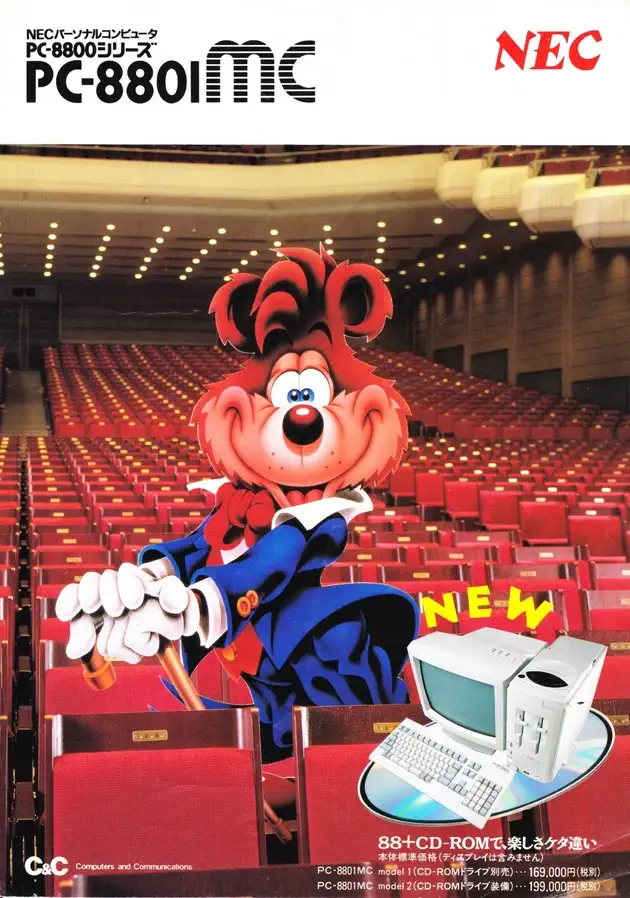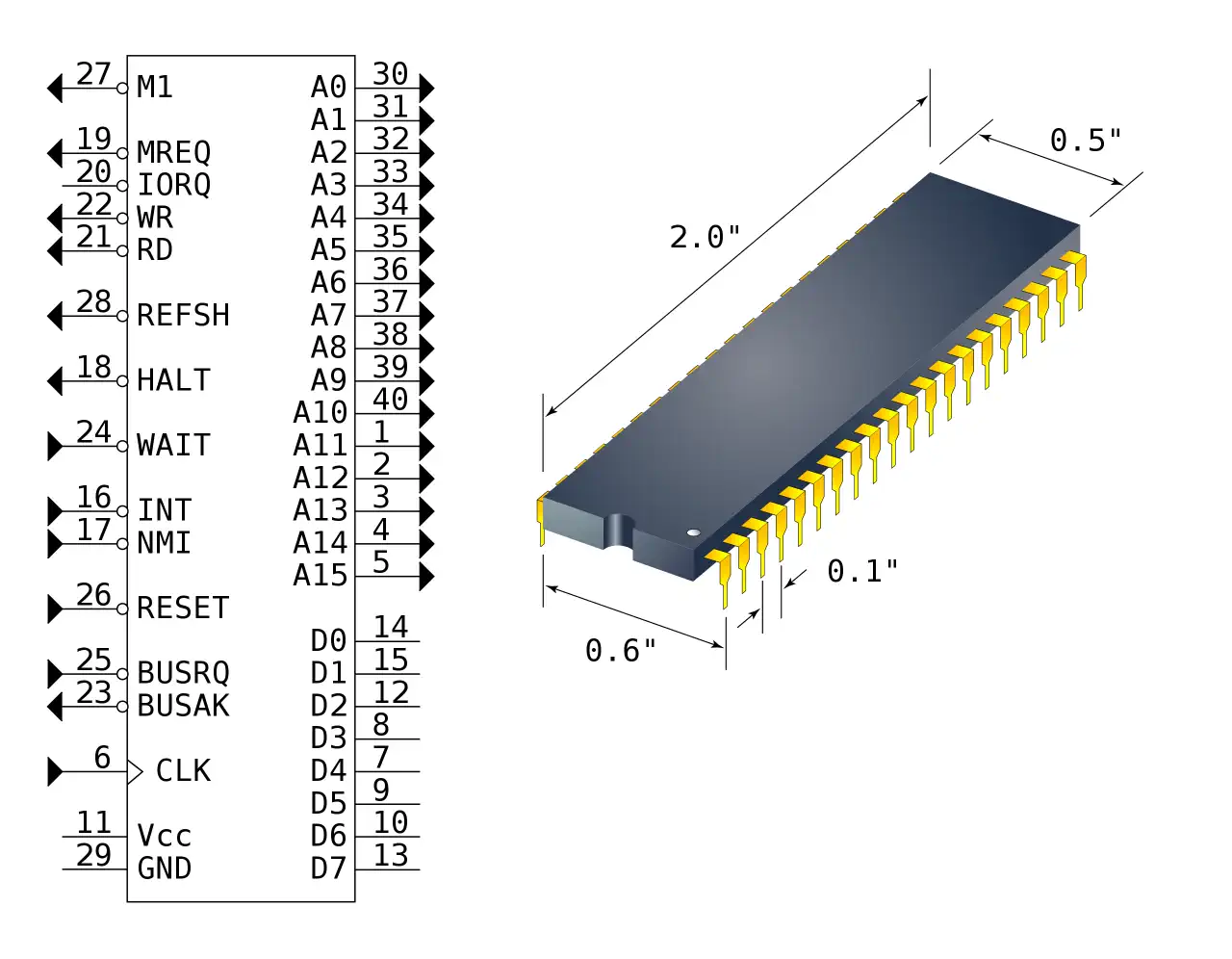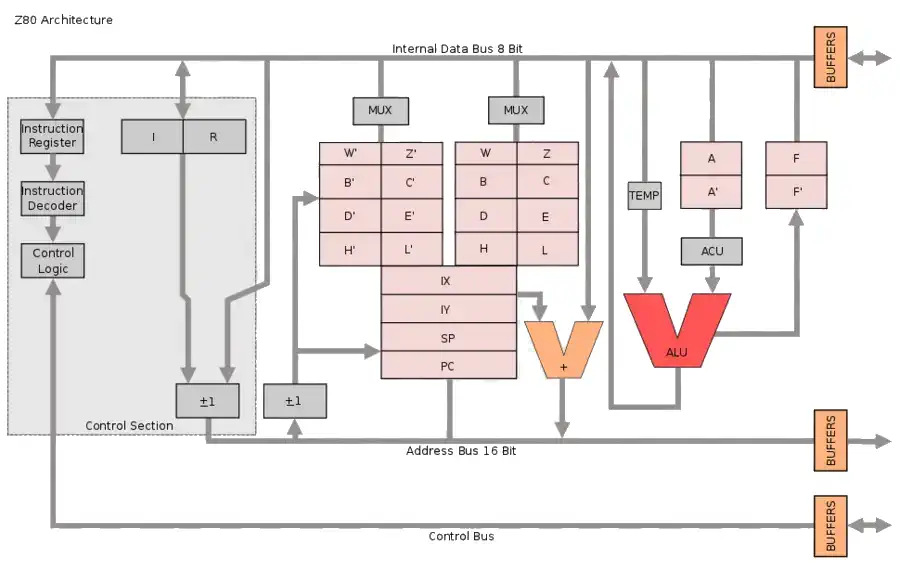NEC PC-8801 MC
The NEC PC-8801 MC was the first computer by NEC where they chose for the tower design. The top of the case has a cd-rom drive built in, and the two disk-drives are mounted vertically in the front of the case. This is the last computer that NEC produced in the PC-8801 series. The 8-bit era had come to an end and 16-bit computers were common place. Still, NEC had an enormous following in Japan due to the huge software library that was produced for the PC-8801 line.


NEC PC 8800 series
The NEC PC-8800 series is a range of home computers manufactured by NEC for the Japanese market between 1981 and 1989. The series began with the launch of the PC-8801 and was marketed as a high-end home computer.
In October of 1982 NEC also launched a 16-bit series of computer, the PC-9800 series. Eventually these computers morphed into NEC branded IBM-PC compatible computers.
Programming on the PC-8800 series
The PC-8800 series uses a pair of powerful programming languages: N-BASIC and N88-BASIC. The use of N-BASIC makes the computer compatible with programs written for the NEC PC-8000 series, while N88-BASIC gives the PC-8800 series even more capabilities, especially for graphics. In addition the use of N88-BASIC gives the computer full advantage of memory, to use all of the 64kByte RAM for data and programs.
Sound and Graphics of the NEC PC-8800 series
NEC PC-8800 Sound Capabilities The early computers in the PC-8800 series use a simple internal speaker, much like the Apple II and the IBM PC computers. Later models added FM-synthesis chips for much better music and sound-effects in games.
NEC PC-8800 Graphics modes: Not all modes are available on all machines, see above for the modes available for this machine. The PC-8800 line graphics chip-sets are backwards compatible.
- N mode - PC-8000 series compatible graphics mode
- V1 mode
- 640(or 320)x200 in 8 colors
- 640(or 320)x400 in 2 colors
- V2 mode
- 640x200 in 8 colors out of a 512 color palette
- 640x400 in 2 colors out of a 512 color palette
- V3 mode
- 640x200 in 65536 colors
- 640x400 in 256 out of 65536 colors
- 320x200 in 65536 colors
- 320x400 in 64 out of 65536 colors
In V1/V2 400 line mode, the R and B planes are combined to create the greater resolution, at the cost of color depth, only monochrome graphics are available. The G plane is not used for display, and can be used as additional work memory to store data.
List of PC-88 models grouped by their Graphics and Sound capabilities:
- CPU - µPD780C-1 @ 4MHz
- Memory - 64 KByte RAM, 48 KByte VRAM
- Graphics Modes- N-Mode, V1 Mode
- Sound - Beeper
- CPU - µPD780C-1 @ 4MHz
- Memory - 64 KByte RAM, 48 KByte VRAM
- Graphics Modes- N-Mode, V1 Mode
- Sound - Beeper & Optional YM2149 FM
- CPU - µPD780C-1 @ 4MHz
- Memory - 64 KByte RAM, 48 KByte VRAM
- Graphics Modes - N-Mode, V1 Mode, V2 Mode
- Sound - YM2203 Mono FM Synthesis
- CPU - µPD780C-1 @ 4MHz
- Memory - 64 KByte RAM, 48 KByte VRAM
- Graphics Modes - V1 Mode, V2 Mode
- Sound - YM2203 Mono FM Synthesis
- CPU - µPD780C-1 @ 4MHz
- Memory - 192 KByte RAM, 48 KByte VRAM
- Graphics Modes - V1 Mode, V2 Mode
- Sound - YM2203 Mono FM Synthesis
- CPU - µPD70008 @ 8MHz
- Memory - 64 KByte RAM, 48 KByte VRAM
- Graphics Modes - V1 Mode, V2 Mode
- Sound - YM2203 Mono FM Synthesis
- CPU - µPD70008 @ 8MHz
- Memory - 192 KByte RAM, 48 KByte VRAM
- Graphics Modes - V1 Mode, V2 Mode
- Sound - YM2203 Mono FM Synthesis
- CPU - µPD90002 @ 8MHz
- Memory - 512 KByte RAM, 256 KByte VRAM
- Graphics Modes - V1 Mode, V2 Mode, V3 Mode
- Sound - YM2203 Mono FM Synthesis
- CPU - µPD70008 @ 8MHz
- Memory - 64 KByte RAM, 48 KByte VRAM
- Graphics Modes - V1 Mode, V2 Mode
- Sound - YM2608 Stereo FM + Mono ADPCM
- CPU - µPD70008 @ 8MHz
- Memory - 192 KByte RAM, 48 KByte VRAM
- Graphics Modes - V1 Mode, V2 Mode
- Sound - YM2608 Stereo FM + Mono ADPCM
- CPU - µPD90002 @ 8MHz
- Memory - 512 KByte RAM, 256 KByte VRAM
- Graphics Modes - V1 Mode, V2 Mode, V3 Mode
- Sound - YM2608 Stereo FM + Mono ADPCM
Yamaha YM2608 FM Sound Chip
The YM2608 is a member of Yamaha's OPN family of FM Synthesis chips. It is the successor of the YM2203 and was widely used in the later lines of the NEC PC-8801 and PC-9801 series of computers.
The Yamaha 2608 doubles the number of FM channels to 6, where the YM2203 had three. Each channel has four operators that can generate sine waves that can be combined, fed as input of another operator, to generate the final FM sound. There are eight possible operator interconnections for producing the different types of instrument sounds. The chip also includes the YM2149 SSG chip (Software Sound Generator). The SSG provides three sound channels, a noise generator and two 8-bit GPIO ports.
Because the YM2608 has six channels vs the three channels of the YM2203, the chip is used with a YM3016 stereo Digital to Analog Converter (DAC) to create stereo FM sound.
CPU View - Zilog Z80 Family
The Z80 quickly became popular in the personal computer market, with many early personal computers, such as the TRS-80 and Sinclair ZX80, using the Z80 as their central processing unit (CPU). It was also widely used in home computers, such as the MSX range, SORD, and the Amstrad CPC, as well as in many arcade games. Additionally, it was also used in other applications such as industrial control systems, and embedded systems. The Z80 was widely used until the mid-1980s, when it was gradually replaced by newer microprocessors such as the Intel 80286 and the Motorola 68000.
The Z80 microprocessor was developed by Zilog, a company founded by Federico Faggin in 1974. The Z80 was released in July 1976, as a successor to the Intel 8080. It was designed to be fully compatible with the 8080, but also included new features such as an improved instruction set, more powerful interrupts, and a more sophisticated memory management system.
The Z80 quickly became popular in the personal computer


VRAM: 48kB Sound Chip Yamaha YM2608 Sound Stereo YM2608 FM + Mono ADPCM Display Chip none Display 640x200 (3 screens), 640x400 (1 screen), 8 out of 512 colors Best Color 8 out of 512 colors Graphics 620x400 in 2 from 512 colors Sprites n/a System OS N88-BASIC Storage Two 5.25 internal Disk Drives. Original Price ¥169,000

